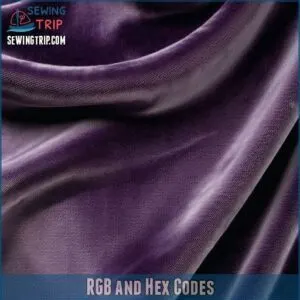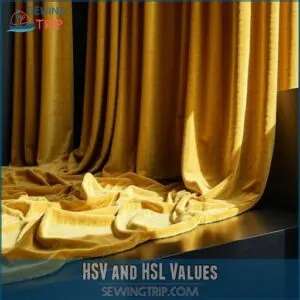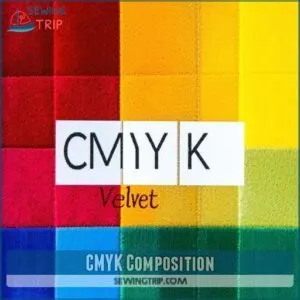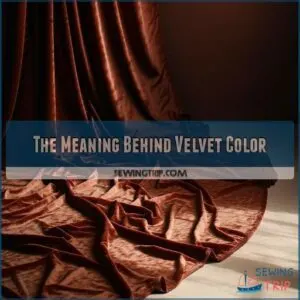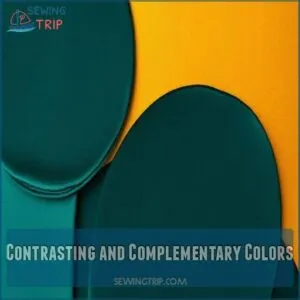This site is supported by our readers. We may earn a commission, at no cost to you, if you purchase through links.
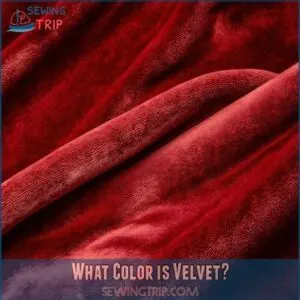
Think of it like a chameleon – adaptable and versatile. You’ll find that the RGB code can vary widely depending on the specific dye used. For example, a deep red velvet might have an RGB value quite different from a pale pink one.
Understanding these color codes is key to using velvet effectively in design projects. We’ll explore more color options and their fascinating history further down the line.
Table Of Contents
Key Takeaways
- You’ll find velvet in a wide range of colors, not just red.
- Velvet’s primary color is a medium-dark pinkish-red, with variations in shade and tone.
- You can represent velvet’s color using various color codes like RGB, hex, HSV, HSL, and CMYK, depending on your needs.
- Velvet’s color symbolism varies across cultures and contexts, representing luxury, passion, and tradition.
What Color is Velvet?
Picture a color that steps right out of the dark crimson family with a vibrant bounce—Velvet is that shade. This medium-dark pinkish-red hue seems to straddle the line between boldness and elegance, bright yet understated.
Like a secret whispered from the depths of history, Velvet’s medium lightness and high saturation have been enchanting and full of personality.
According to Velvet Color Meaning, Velvet symbolizes affection, devotion, and individuality, making it a popular choice for weddings and bold fashion statements.
Whether you’re marveling at its richness in fashion or its warmth in home decor, this color never fails to make a statement.
Velvet’s allure is like finding an unexpected treasure in your grandmother’s attic—suddenly, it feels familiar yet thrillingly fresh in its timelessness and potential across various creative avenues.
Shades and Tints of Velvet
Ever wondered about the subtle nuances of velvet’s rich color? Think beyond just "red"—it’s a journey into pinkish-red depths. Velvet’s a warm, medium-dark shade, boasting high saturation. This means it’s vibrant and eye-catching, a true statement piece.
Vintage velvet hues—think antique velvet’s dark browns or cream velvet’s ivory softness. You’ll find many shades, tints, and tones within the velvet family; each offers a unique expression. From deep crimson to lighter, almost rosy variations, the possibilities are endless. The beauty lies in discovering the perfect match for your project. Finding your ideal velvet color is an adventure.
These shades offer endless possibilities, from bold fashion statements to calming home décor. Exploring velvet color trends gives you a world of inspiration, influencing your design choices. And remember, the right shade of velvet can dramatically change the mood of a space, adding richness and depth.
Velvet Color Codes
When exploring velvet’s color codes, you’ll discover a plethora of ways to express its unique beauty through numbers.
From RGB and hex codes to HSV and CMYK, these values offer precise guidance for capturing velvet’s rich allure in your design projects.
RGB and Hex Codes
Understanding Velvet’s color codes is like painting with light. Its RGB values reflect 46% red, 3% green, and 32% blue, creating its rich hue.
The hex code, #902C3E, captures Velvet’s mystique.
Imagine using a color picker to match this precise tone for a project:
- Bold Red Base
- Subtle Green Tint
- Deep Blue Undertone
- Vivid Saturation
- Regal Elegance
HSV and HSL Values
When you think about Velvet’s color, it’s alive with HSV and HSL dimensions.
Velvet’s luxurious sheen is greatly attributed to its cut pile construction, a key characteristic shared with other plush fabrics like velour.
In the color wheel, velvet’s hue is 320°; it’s kind of like the rockstar of pinkish-reds, with 93% saturation in HSV and 85% in HSL.
This posh, bold color commands a second look, isn’t just seen—it’s felt.
CMYK Composition
To capture velvet’s distinct pinkish-red hue in print, check out its CMYK values: 0% cyan, 93% magenta, 31% yellow, and 54% black.
This unique mix brings velvet to life in design projects, ensuring vibrant, consistent reproduction.
So, whether you’re flipping through color swatches or setting up your next masterpiece, velvet’s CMYK roadmap is your guide to printing perfection!
The Meaning Behind Velvet Color
When you think of velvet, you might picture luxury and sophistication, but its rich color also carries layers of meaning and cultural significance.
Velvet’s deep hues can symbolize passion, elegance, and individuality, making it a beloved choice in fashion and design.
Symbolism and Use in Culture
Velvet, a vibrant pinkish-red, struts its cultural impact with a regal flair.
It whispers love at weddings, adding warmth and luxury to homes.
Art sees it as a muse for passion; religion clothes it in devotion.
Even military threads it with authority, making velvet a color of intimacy and power, leaving its mark through history and beyond.
Velvet in Fashion and Design
Velvet’s luxurious feel isn’t just for grandma’s antique furniture.
Modern velvet trends are everywhere—from stylish sofas to bold fashion statements.
Think rich jewel tones in vintage velvet, or playful pops of color in modern velvet.
You can incorporate these styles into your home or wardrobe by exploring various velvet colors online at velvet color products.
Velvet textures add depth and warmth, perfect for upholstery and fashion alike.
Explore the versatile world of velvet!
Contrasting and Complementary Colors
In terms of velvet’s contrasting and complementary colors, you’ve got plenty of options to spice up your designs.
Pairing velvet with white creates striking contrast.
Combining it with shades like dark cyan adds a harmonious, bohemian flair.
High Contrast With White
Picture a space that screams elegance: white and velvet contrast creates a dramatic and eye-catching design.
By using the color wheel to find complementary colors like these, you can create a striking effect, as explained in color matching principles.
This high contrast design is like a black tie event in your living room—bold but sophisticated.
But remember, too much drama can be overwhelming, so balance it with softer textures or accents to keep things from feeling like a velvet and white rollercoaster.
Color Combinations and Palettes
Elevate your design game by pairing Velvet with complementary colors.
Get a bohemian vibe with dark moderate cyan or opt for a monochromatic scheme with moderate red.
Velvet’s high saturation and warm tone create harmony, perfect for home decor and fashion inspiration.
For more velvet color combinations that can elevate your design, check out these velvet color palettes velvet color combinations.
Explore Velvet color trends and discover the psychology behind this luxurious hue.
Velvet in Academic Regalia
Velvet plays a significant role in academic regalia, accentuating hoods and gowns with vibrant colors that denote various fields of study.
Velvet and its rich texture and shades represent tradition and scholarly achievement.
As you explore these distinctions, you’ll appreciate how the rich texture and shades of velvet represent tradition and scholarly achievement.
Hood Degree Color Chart
Choosing the right velvet color for your academic hood is like picking the perfect shoes for a special occasion—each hue tells a story.
From white for Arts to red for Theology, these colors aren’t just fabric decorations, but vivid symbols steeped in centuries of tradition and meaning.
Academic hoods and their colors reflect the rich history and esteemed nature of each discipline.
Color Origins and Significance
In academic regalia, color origins carry deep significance.
Velvet trims highlight fields of study, with purple symbolizing law and gold representing scientific pursuits.
For those interested in purchasing academic regalia incorporating velvet, online retailers like Academic Velvet Regalia offer a range of options.
These vibrant hues are more than fabric—they’re a legacy of color symbolism and cultural reverence.
Velvet’s luxurious history in academia inspires pride and respect, blending tradition with meaningful color psychology.
Frequently Asked Questions (FAQs)
What color is velvet?
Velvet boasts a medium-dark, bright pinkish-red hue, a vibrant member of the dark crimson color family.
It’s loved for its boldness and versatility in fashion and decor.
With high saturation and rich history, it’s loved for its boldness and versatility in fashion and decor.
What color is velvet HTML?
Imagine a vibrant sunset captured on fabric—velvet’s HTML representation is #902C3E. This medium-dark pinkish-red shade blends 46% red, 3% green, and 32% blue, offering a rich, luxurious visual in digital design.
What color is red velvet fabric?
Red velvet fabric boasts a rich, deep crimson hue with a luxurious sheen.
It’s that kind of fabric that calls out sophistication and style.
Reminiscent of classic movie theaters and opulent noble attire, softly whispering elegance.
Is velvet always red?
Picture velvet as a chameleon of fabric, not always red, but also black, blue, or cream.
It’s a versatile and luxurious material with a palette as rich as its history.
Always offering something unique and alluring.
What color is black velvet fabric?
Black velvet fabric is a deep, rich shade ranging from charcoal gray to intense black.
It embodies sophistication and mystery.
Adding a luxurious and dramatic flair to fashion and decor, much like a moonlit night.
What colors are similar to Velvet?
Wow, you’re diving deep into color! Shades like crimson, burgundy, and deep rose are your best bets; they’re velvet’s closest cousins. Think rich, jewel tones.
What color matches with velvet?
Velvet pairs beautifully with dark cyan for a bohemian vibe.
Try it with white for striking contrast.
Or blend it with moderate red in a monochromatic scheme.
Each combination offers unique style options to suit your decor needs. This is a versatile fabric.
What is velvet color paint?
Did you know the lush velvet color paint, with its rich, pinkish-red hue, evokes luxury and warmth in any space?
Perfect for adding depth and charm, it transforms bland rooms into cozy retreats brimming with personality.
What kind of fabric is velvet?
You’re likely familiar with velvet as a luxurious fabric,
but technically, it’s a type of woven fabric with a soft, plush pile,
typically made from cotton, silk, or synthetic fibers,
offering a rich, smooth texture.
What is the color code for velvet red?
The hex code for velvet red is #902C3E.
This rich, pinkish-red hue offers a bold and vibrant aesthetic.
Incorporating it into designs can add depth and elegance, making it perfect for daring fashion and home decor.
Conclusion
Velvet’s dazzling color versatility is nothing short of miraculous!
You might think you’ve explored it all, but with each shade and design insight, there’s always more to discover.
Whether you’re selecting deep crimson for drama or soft pastels for elegance, understanding the RGB, HSV, and CMYK codes empowers you in design projects.
Velvet’s rich symbolism and use in fashion or academia adds another layer of intrigue, making your creative choices both informed and inspired.
What color is velvet? The answer is yours to create!

